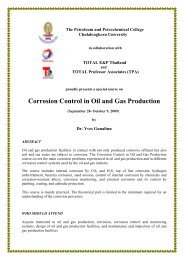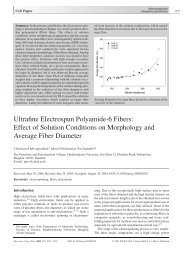Removal of solvent-based ink from printed surface of HDPE bottles ...
Removal of solvent-based ink from printed surface of HDPE bottles ...
Removal of solvent-based ink from printed surface of HDPE bottles ...
You also want an ePaper? Increase the reach of your titles
YUMPU automatically turns print PDFs into web optimized ePapers that Google loves.
DTAB, 3.75 mM for TTAB, and 0.97 mM for CTAB).<br />
Specifically, 10% <strong>of</strong> <strong>ink</strong> could be removed <strong>from</strong> the <strong>surface</strong><br />
<strong>of</strong> <strong>printed</strong> <strong>HDPE</strong> sheets when the concentrations <strong>of</strong> CnTAB<br />
solutions were about 13 times the CMC for DTAB, 4 times<br />
the CMC for TTAB, and about the CMC <strong>of</strong> CTAB,<br />
respectively, while complete de<strong>ink</strong>ing was observed at<br />
concentrations <strong>of</strong> about 24 times the CMC for DTAB, 8<br />
times the CMC for TTAB, and 4 times the CMC for CTAB,<br />
respectively. The de<strong>ink</strong>ing efficiency <strong>of</strong> these cationic<br />
surfactants was obviously found to increase with increasing<br />
both the concentration and the alkyl chain length <strong>of</strong> the<br />
surfactants.<br />
Interestingly, only CTAB showed the ability to remove<br />
the <strong>ink</strong> at concentrations close to its CMC, while a very<br />
high concentration was required in the case <strong>of</strong> DTAB. The<br />
zeta potential and wettability results at concentrations less<br />
than its CMC imply that CTAB adsorbed onto the <strong>ink</strong> <strong>surface</strong><br />
in a much greater extent than both TTAB and DTAB<br />
either at constant concentration below the CMC (Figs. 3,<br />
5a, and 7) or at the CMC (Figs. 3 and 5b). We were unable<br />
to measure surfactant adsorption onto the <strong>ink</strong> directly by<br />
the solution depletion method because we could not obtain<br />
a representative sample <strong>of</strong> <strong>ink</strong> by scraping <strong>from</strong> the<br />
plastic <strong>surface</strong>, and the pre<strong>printed</strong> <strong>ink</strong> does not have the<br />
same binder/pigment interaction as when <strong>printed</strong>. Therefore,<br />
we hypothesize that surfactant adsorption is responsible<br />
for increased zeta potentials and increased de<strong>ink</strong>ing.<br />
Since surfactant adsorption increases with concentration<br />
Viscosity (cP)<br />
Viscosity (cP)<br />
0.88<br />
0.86<br />
0.84<br />
0.82<br />
0.80<br />
0.78<br />
1.6<br />
1.4<br />
1.2<br />
1.0<br />
0.8<br />
a<br />
CTAB<br />
TTAB<br />
0 10 20 30 40<br />
Concentration (mM)<br />
b<br />
DTAB<br />
0.6<br />
0 100 200 300 400<br />
Concentration (mM)<br />
Fig. 10 Viscosity <strong>of</strong> CnTAB solutions as a function <strong>of</strong> initial<br />
CnTAB concentration for a CTAB and TTAB, and b DTAB. Arrows<br />
indicate CMC values<br />
below the CMC and plateaus above the CMC [25], this<br />
plateau behavior in contact angle (Fig. 3) and zeta potential<br />
(Fig. 5a) is consistent with the correlation between wettability,<br />
zeta potentials, and surfactant adsorption. The critical<br />
concentration for the formation <strong>of</strong> admicelles on the<br />
<strong>ink</strong> <strong>surface</strong> (i.e., critical admicelle concentration; CAC) is<br />
much lower than the critical concentration for the formation<br />
<strong>of</strong> micelles (i.e., CMC) [26, 27]. The longer the alkyl<br />
chain length, the lower the CAC is [28]. As a result, CTAB,<br />
aromatic<br />
ring<br />
hydrophobic<br />
part <strong>of</strong> <strong>ink</strong><br />
Ink<br />
<strong>HDPE</strong><br />
a Step 1: <strong>surface</strong> adsorption<br />
CnTAB<br />
b Step 2: solubilization <strong>of</strong> binder<br />
Ink<br />
<strong>HDPE</strong><br />
negative charge<br />
<strong>of</strong> <strong>ink</strong><br />
c Step 3: detachment <strong>of</strong> pigment particles<br />
<strong>HDPE</strong><br />
987<br />
d Step 4: stabilization and dispersion <strong>of</strong> detached pigment particles<br />
Fig. 11 Proposed four-step mechanism for removal <strong>of</strong> <strong>solvent</strong><strong>based</strong><br />
blue <strong>ink</strong> <strong>from</strong> <strong>HDPE</strong> <strong>surface</strong>





